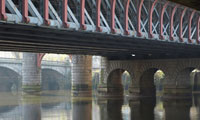 Sound art is here to stay
Sound art is here to staySound artist Susan Philipsz's inclusion on the Turner prize shortlist should make Britain sit up and listen
Changing the way we listen ... Susan Philipsz's sound installation Lowlands (2010). Photograph: Eoghan McTigue/Tanya Bonakdar Gallery/PA
The presence of Susan Philipsz, an artist who works primarily with sound, on the Turner prize shortlist is welcome but overdue recognition for a major part of our cultural life. Sound art is nothing new: it has its roots in the early 20th century, with the dadaists and futurists – perhaps even as far back as prehistory, when someone first hung a gourd rattle in a tree just because they liked how it sounded when the wind blew.
And, in London at least, the sound art scene has never seemed so vibrant: Céleste Boursier-Mougenot's guitar-playing finches at the Barbican; Florian Hecker's solo exhibition at the Chisenhale gallery; the extraordinary range of work at the AV festival; and Bill Fontana's installation River Sounding in the light wells under Somerset House. The Turner judges have taken the first step in what will turn out to be a long and interesting journey .
But what actually is "sound art"? The answer is that it's hard to define narrowly. There are fruitful overlaps with contemporary classical composition, experimental rock music and improvisation. Sound artists use everything from sine wave generators to lectures, wildlife recordings, public space, bell ringing, electromagnetic fields – even the odd folk song.
More importantly, perhaps, sound art can be as much to do with the act of listening as it is with making the work. Many of us now live in a world of visual and auditory overload. We happily make do with a pixelated version of music on our MP3 players, and end up hearing things we do not want to. We tolerate buildings and public spaces that look OK, but sound terrible. We eat and shop in places where music and noise are calibrated just short of inducing hysteria. We stick our fingers in our ears when trains screech on dirty tracks.
For those of us who live under flight paths or in hectic, noise-filled cities, the recent cloud of volcanic ash brought with it something astonishing – the revelation of hearing the sound of birds and insects for the first time.
Clearly it would be daft to claim that sound art can be instrumental in resolving all, or any, of the above. But maybe it's a start. And, as a more modest proposal in the meantime, I would suggest that taking some time out to visit Fontana's River Sounding, or Chris Watson's forthcoming Whispering in the Leaves in the Palm House at Kew, or Paul Rooney's sound work McKenzie in Liverpool later this month. All will change how you listen to the world.
 Sound art is here to stay
Sound art is here to stay